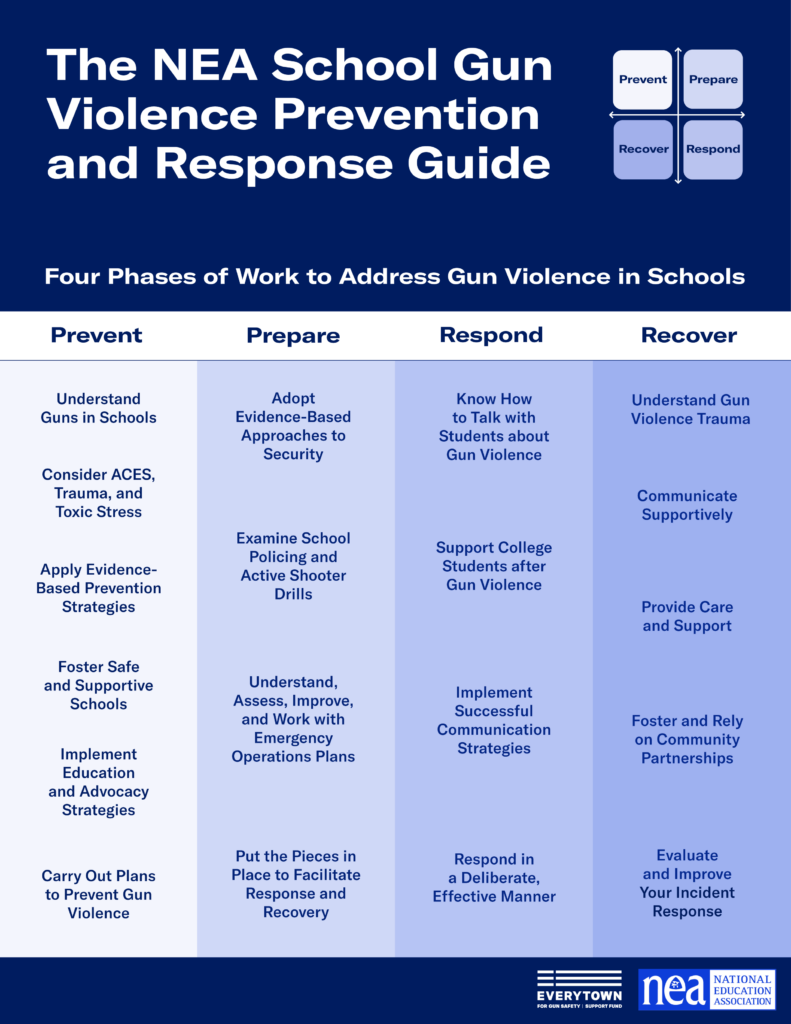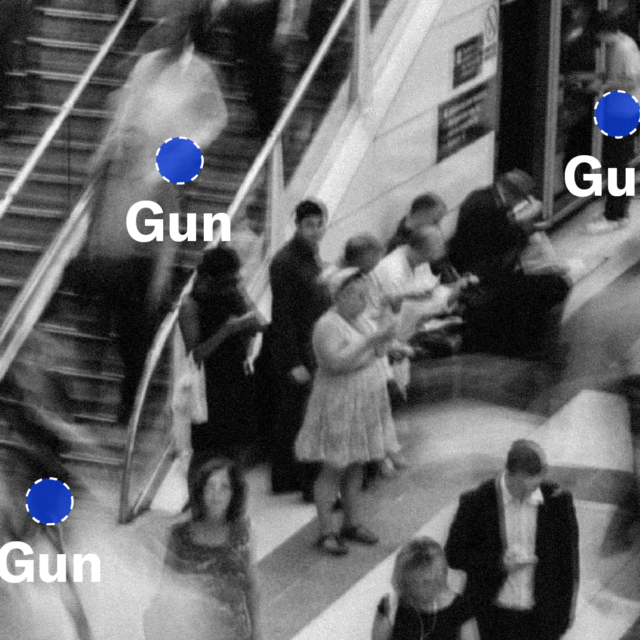NEA School Gun Violence Prevention and Response Guide

Why This Guide
The United States suffers from an epidemic of gun violence. Every day, more than 120 people are killed by guns, and more than 200 are shot and wounded.1Everytown for Gun Safety Support Fund, How does gun violence impact the communities you care about? Retrieved February 14, 2024, from EveryStat: https://everystat.org/; The Everytown for Gun Safety Support Fund developed a yearly average based on the most recent Centers for Disease Control and Prevention gun death data available (2018–2022). Less than 1 percent of gun deaths per year occur on school grounds, but the impact extends far beyond these casualties: Gun violence shapes the lives of millions of people in this country who witness it, who know the victims, or who live in fear of the next shooting. Gun violence has a profoundly harmful impact on students, educators, families, and communities.
For most of this country’s history, infectious diseases and car accidents constituted the greatest risks to childhood health, but today, gun violence is the No. 1 cause of death for children and teens. Each year, more than 4,000 children and teens are shot and killed, and more than 17,000 are shot and wounded.2The Impact of Gun Violence on Children and Teens. Retrieved February 14, 2024, from Everytown for Gun Safety Support Fund: https://everytownresearch.org/report/the-impact-of-gun-violence-on-children-and-teens/ Homicides account for roughly 6 in 10 gun deaths among children,3The Impact of Gun Violence on Children and Teens. Retrieved February 14, 2024, from Everytown for Gun Safety Support Fund: https://everytownresearch.org/report/the-impact-of-gun-violence-on-children-and-teens/ and gun suicides are on the rise—a public health crisis4American Public Health Association. (2023). Gun Violence Is a Public Health Crisis. Retrieved February 14, 2024, from https://www.apha.org/-/media/files/pdf/factsheets/200221_gun_violence_fact_sheet.ashx that communities and elected officials can prevent. In the United States, an estimated 3 million children per year are exposed to shootings,5Finkelhor, D., & et al. (2015). Prevalence of Childhood Exposure to Violence, Crime, and Abuse: Results from the National Survey of Childhood Exposure to Violence. JAMA Pediatrics, 169(8), 746-754. Retrieved February 16, 2024, from https://jamanetwork.com/journals/jamapediatrics/fullarticle/2344705. and the trauma of witnessing shootings—whether in their schools, communities, or homes—can have a devastating impact on their lives. The Stress in America survey provides ample evidence of the collective trauma our country faces, including from mass shootings.6American Psychological Association. (2023, November). Press Release: Stress in America 2023: A nation recovering from collective trauma. Retrieved February 22, 2024, from American Psychological Association: https://www.apa.org/news/press/releases/stress/2023/collective-trauma-recovery.
The Everytown Support Fund’s Gunfire on School Grounds database details the myriad ways in which gun violence manifests in U.S. schools. Over the past 11 years, the Everytown Support Fund has identified at least 1,200 incidents of a firearm discharging a live round inside or into a school building or on or onto school grounds. Of these incidents, 841 occurred on the grounds of a prekindergarten, elementary, middle, or high school, resulting in 270 people killed and 580 people wounded. In the 326 incidents that occurred on university or college campuses during that time period, 120 people were killed and another 251 were wounded.7Gunfire on School Grounds in the United States. Retrieved May 24, 2024, from Everytown for Gun Safety Support Fund: https://everytownresearch.org/maps/gunfire-on-school-grounds/
Students exposed to the trauma of violence, crime, and abuse are more likely to suffer from substance use disorders, depression, anxiety, and post-traumatic stress disorder (PTSD); fail or have difficulties in school; and engage in criminal activity.8Finkelhor, D., & et al. (2015). Prevalence of Childhood Exposure to Violence, Crime, and Abuse: Results from the National Survey of Childhood Exposure to Violence. JAMA Pediatrics, 169(8), 746-754. Retrieved February 16, 2024, from https://jamanetwork.com/journals/jamapediatrics/fullarticle/2344705; Cronholm, P., & et al. (2015, September). Adverse Childhood Experiences Expanding the Concept of Adversity. American Journal of Preventive Medicine, 49(3), 354-361. doi:https://doi.org/10.1016/j.amepre.2015.02.001 Even for those who have not experienced gun violence at school, the trauma of experiencing lockdowns and active shooter drills—which are happening with notable frequency—leaves students, educators, and their families across the country experiencing firsthand the impact of fear from the anticipation of gun violence.
The National Education Association (NEA) remains committed to ending the scourge of gun violence. As NEA President Becky Pringle told the U.S. House Committee on Oversight and Reform in testimony urging Congress to act to end gun violence, “Inaction means we are willing to accept what should be unacceptable to us all.”9NEA. (2022, June 8). Press Release: NEA President Becky Pringle testifies at House Committee on Oversight and Reform, urges Congress to end gun violence. Retrieved February 16, 2024, from National Education Association: https://www.nea.org/about-nea/media-center/press-releases/nea-president-becky-pringle-testifies-house-committee-oversight-and-reform-urges-congress-act-end
With attention to the disproportionate impact of gun violence on communities of color, NEA advocates in Congress, develops resources and trainings, encourages media and academic coverage of the subject, mobilizes members and communities, and engages with partners across the country to end gun violence. However, more must be done. To further address gun violence in our schools at every level of education, in July 2022, the NEA Representative Assembly (RA)—the Association’s highest decision-making body—directed NEA to issue a national call to action to help ensure that all students, educators, schools, campuses, and communities are safe from the epidemic of gun violence.
Working with an NEA-wide team that meets regularly to assess, plan, and work toward the ambitious goal set by the RA, the Association has convened members, leaders, and staff across the country to help develop strategies and identify needed actions. As part of its call to action, NEA has partnered with the Everytown for Gun Safety Support Fund (Everytown Support Fund) to produce the NEA School Gun Violence Prevention and Response Guide. The guide helps NEA’s state and local leaders, staff, and worksite leaders, like building representatives and faculty liaisons, prevent, prepare for, respond to, and facilitate recovery from gun violence in all education settings.
Ideally, this guide will be used for planning and advocacy that should already be taking place in Pre-K–12 schools and institutions of higher education. By focusing on the roles of association leaders, staff, and worksite leaders, like building representatives and faculty liaisons, it is meant to complement—not supplant—planning, preparation, and action by school administrators.
In partnership with
-
![]()
NEA
The National Education Association (NEA) is more than 3 million people—educators, students, activists, workers, parents, neighbors, and friends—who believe in the opportunity for all students and the power of public education to transform lives and create a more just and inclusive society. NEA has affiliate organizations in every state and more than 14,000 communities across the United States. NEA’s vision for safe, just, and equitable schools consists of thriving spaces that are safe and welcoming for all students; are discriminatory toward none; integrate the social, emotional, physical, mental, and spiritual needs of the whole student; and equitably and fully fund the community school model with wraparound services and resources. The resources in this guide can help make this vision a reality.





